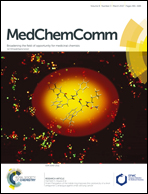Abstract
A series of phenyl 4-[(indol-1-yl)alkyl]piperidine carbamates was synthesized and tested for inhibition of the endocannabinoid degrading enzyme fatty acid amide hydrolase (FAAH) and for metabolic stability in rat liver S9 fractions and porcine blood plasma. Structure–activity relationship studies revealed that variation of the length of the alkyl spacer connecting the indole and the piperidine heterocycle, introduction of substituents into the indole ring, replacement of the piperidine by a piperazine scaffold as well as opening of the piperidine ring system affect activity significantly. The metabolic stability of this compound class proved to be significantly higher than that of corresponding phenyl N-(indol-1-ylalkyl)carbamates.


 Please wait while we load your content...
Please wait while we load your content...